Victorian sunrooms meld historic elegance with abundant natural light, transforming underutilized spaces into luminous retreats. Rooted in 19th-century conservatories, these rooms feature ornate detailing—bay windows, intricate woodwork, and patterned tile—that honor Victorian craftsmanship while accommodating modern comforts. Across twenty inspiring ideas, you’ll discover how to integrate stained-glass accents, botanical motifs, rich color palettes, and period-appropriate furnishings to craft a sunroom that feels both grand and welcoming. From glass-paneled roofs to decorative friezes, each concept balances authenticity with functionality, ensuring your sunroom serves as a serene lounge, indoor garden, or year-round conservatory.
1. Ornate Bay-Window Alcove

Incorporate a three-sided bay window with deep sills to echo classic Victorian design and maximize light intake for seating or display. Frame the windows with carved moldings and matching cornices to reinforce period character while providing visual transition between walls and glass. Install cushioned window seats upholstered in heritage-style fabrics—florals or damasks—to invite relaxation and maintain authenticity. Accent the alcove with a Persian rug beneath the seat to introduce warmth and pattern, complementing the window’s curvature. Finish with lace or sheer curtains hung from brass rods, allowing diffused light and period flair.
2. Patterned Tile Flooring

Select encaustic or terracotta tiles laid in geometric or floral motifs, reflecting Victorian tastes for bold floor patterns that withstand moisture and wear. Choose warm hues—rust, ochre, and deep green—to harmonize with wooden architectural elements and botanical accents. Seal the tiles with a matte finish to evoke authenticity while ensuring spill resistance in a room prone to condensation. Arrange tiles in a border pattern around the room’s perimeter, drawing the eye inward to furnishings or a central rug. Complement with carved wooden radiator covers painted to match window trim, unifying the floor and wall treatments.
3. Leaded-Glass Skylight
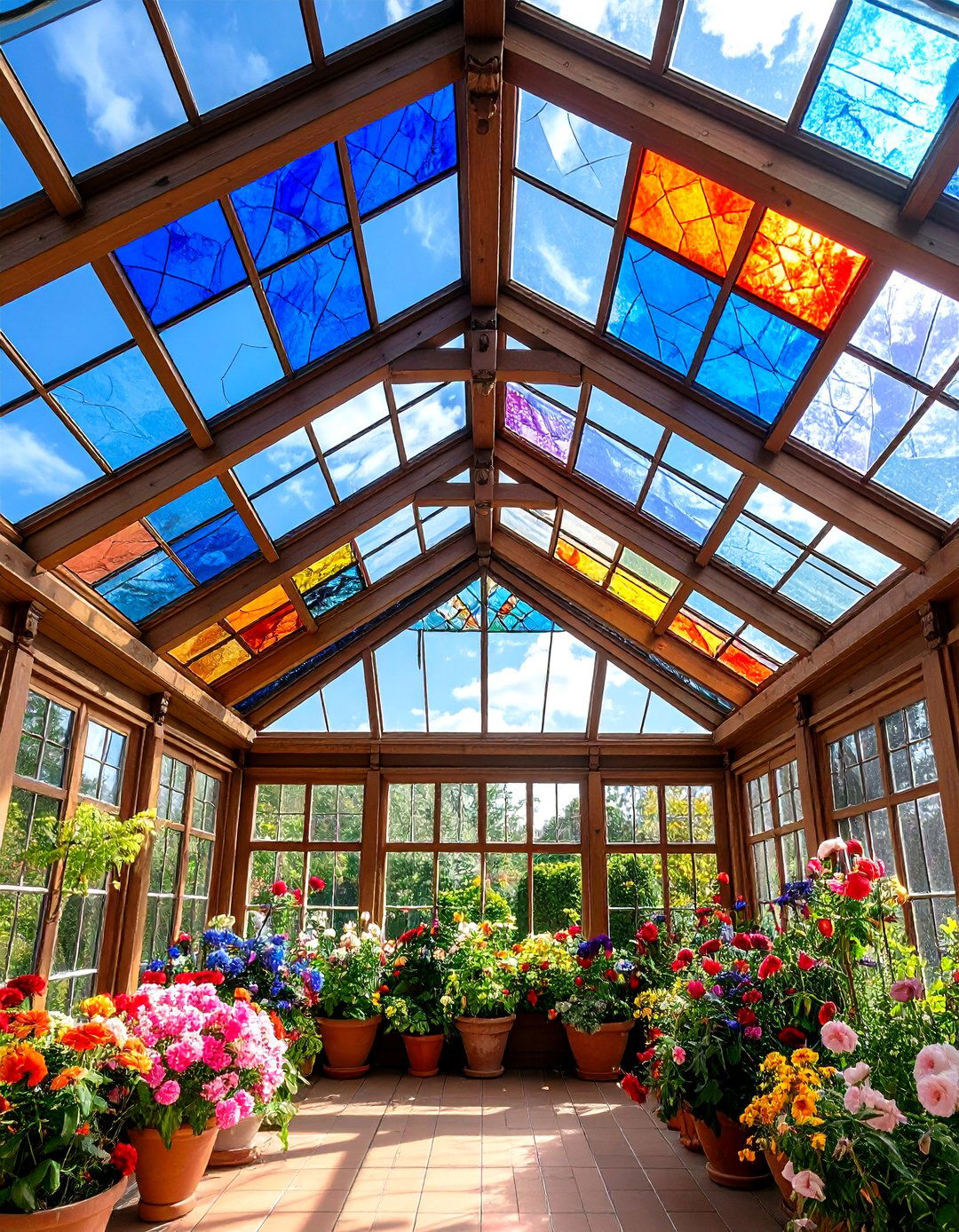
Install a pitched skylight paneled with leaded or stained glass to flood the sunroom with dappled color, replicating Victorian conservatory glazing. Opt for jewel-tone glass—ruby reds, cobalt blues, and emerald greens—arranged in floral or trellis patterns to enhance romantic ambiance. Frame the skylight with decorative wood rafters featuring carved brackets that echo exterior eaves and support visual continuity. Include operable vents or automated louvers to regulate heat buildup while preserving historic detail. Finish roofing intersections with copper flashing that will patinate gracefully, blending function with aged charm.
4. Wrought-Iron Furniture
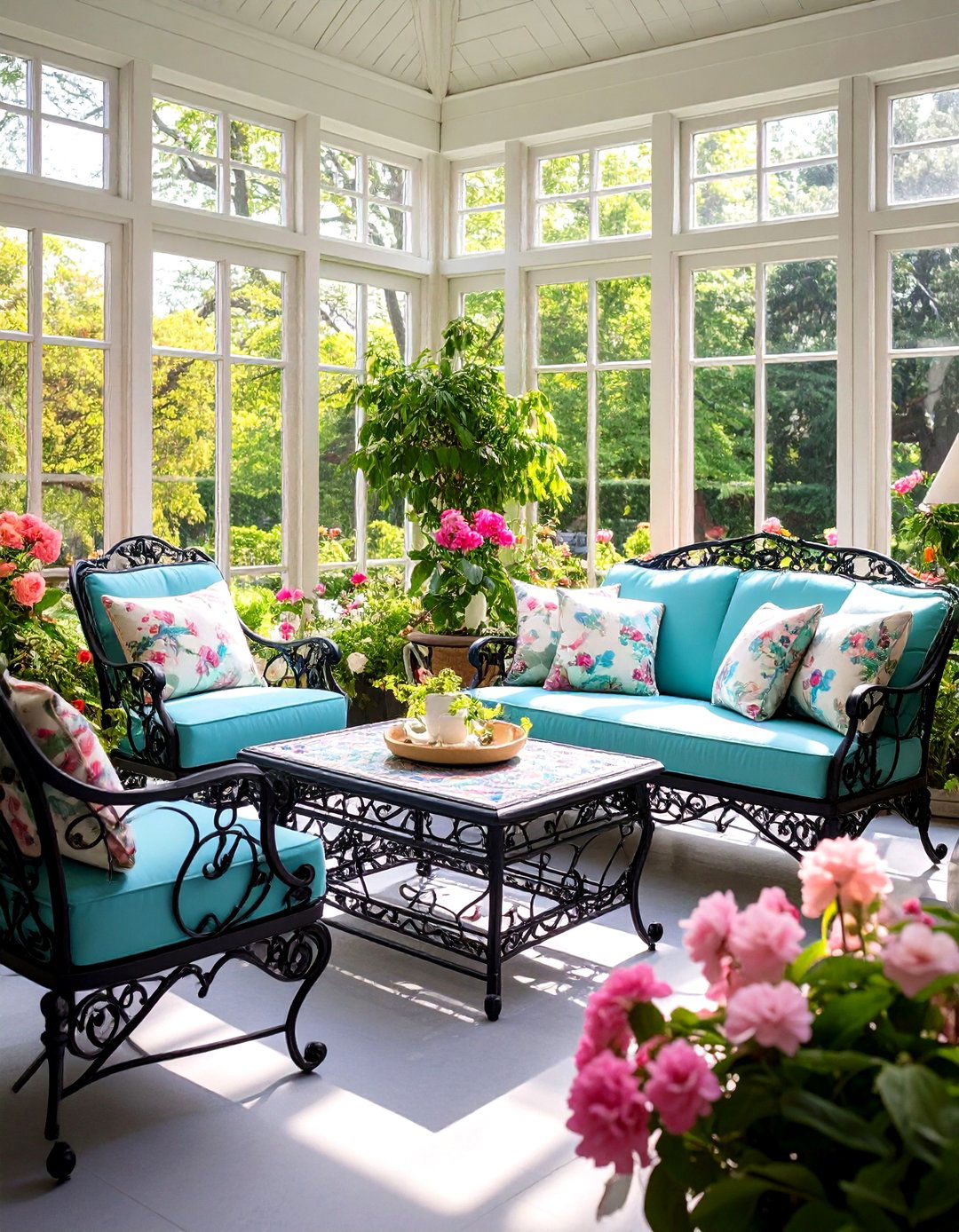
Select wrought-iron seating and tables with scrollwork reminiscent of 19th-century garden conservatories, durable enough for sun-soaked environments. Paint pieces in matte black or verdigris green to simulate vintage oxidation, pairing with plush cushions in deep florals or stripes. Arrange seating around a central accent table topped with mosaic or marble inlay for a centerpiece that feels handcrafted. Integrate slender wrought-iron plant stands to display ferns and trailing ivies, reinforcing the indoor-garden motif. Tie the schema together with an iron chandelier overhead, its arms supporting lantern-style lights for evening warmth.
5. Botanical Wallpaper
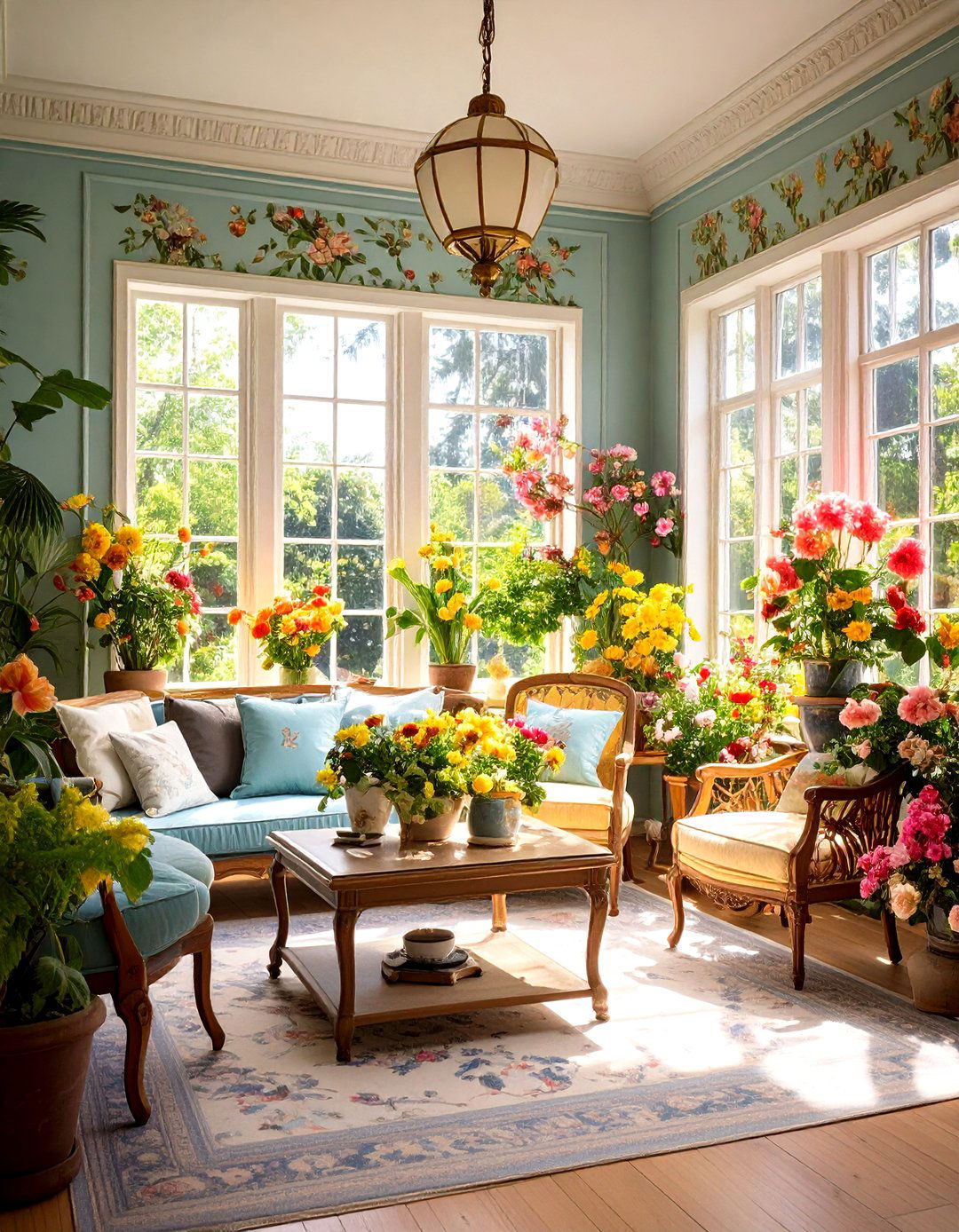
Cover walls above the knee-high wood paneling with botanical-print wallpaper in verdant greens, pale yellows, and soft pinks to evoke Victorian conservatories. Choose designs featuring ferns, palms, and flowering vines to harmonize with live plants and glass elements. Ensure wallpaper is vinyl-coated or otherwise moisture-resistant to handle sunroom humidity. Trim with gilt picture rails to display pressed botanical prints or antique mirrors, integrating decoration and function. Accent corners with slender pilasters, enhancing verticality and framing the pattern for a refined finish.
6. Carved Wood Valances
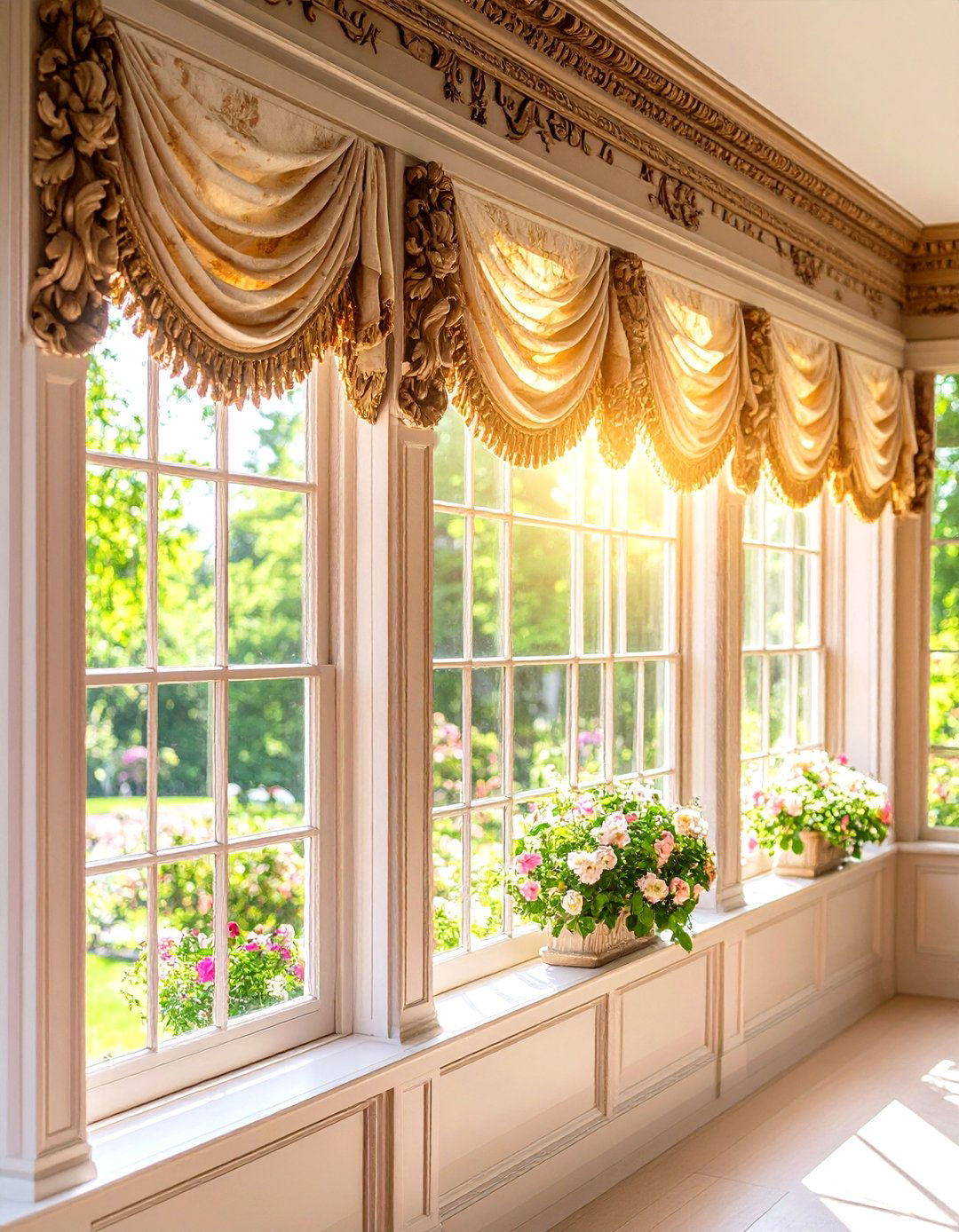
Install carved wooden valances above windows—featuring acanthus leaves, rosettes, or foliate scrolls—to conceal hardware and reinforce historic authenticity. Match the valances’ finish to window trim for a cohesive palette, whether stained oak or painted cream. Incorporate integrated, retractable shades behind the valances, offering sun control without compromising design. Enhance detailing with hand-applied gold leaf highlights to catch sunlight and emphasize carving depth. Complete the treatment with coordinating tasselled tiebacks that settle draperies gracefully to the floor.
7. Tiffany-Style Stained-Glass Lamp
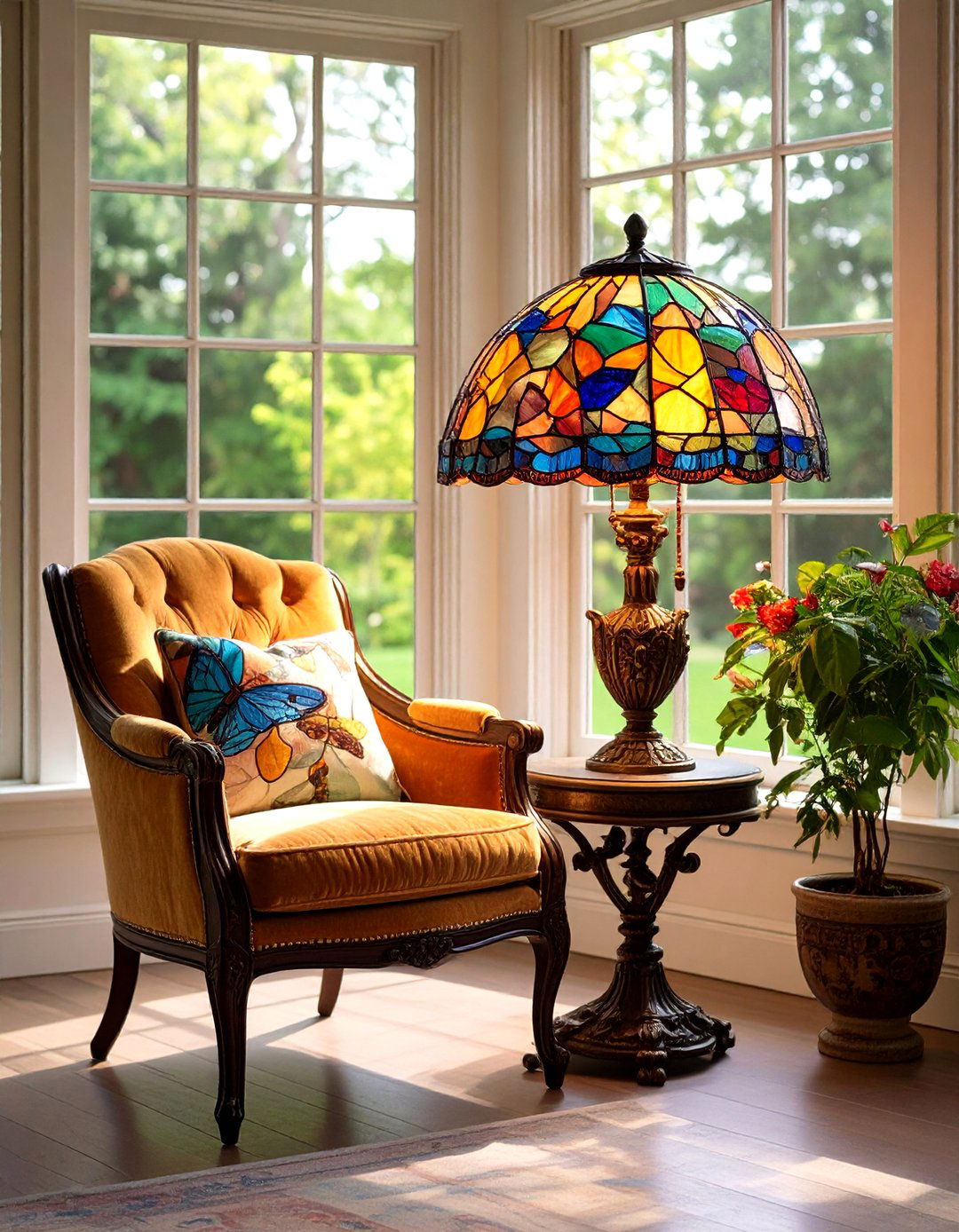
Position a Tiffany-style floor or table lamp featuring leaded-glass panels—depicting dragonflies or floral motifs—to cast colorful pools of light after dusk. Choose lamps with bronze or patinated copper bases to echo other metal accents in the room. Situate the lamp beside a reading chair or chaise longue upholstered in velvet for a cozy nook. Balance with smaller stained-glass suncatchers in windows to reflect colored light across walls and floors. Use LED bulbs with warm-white tones to keep energy use low while preserving authentic glow.
8. Indoor Fountain Feature
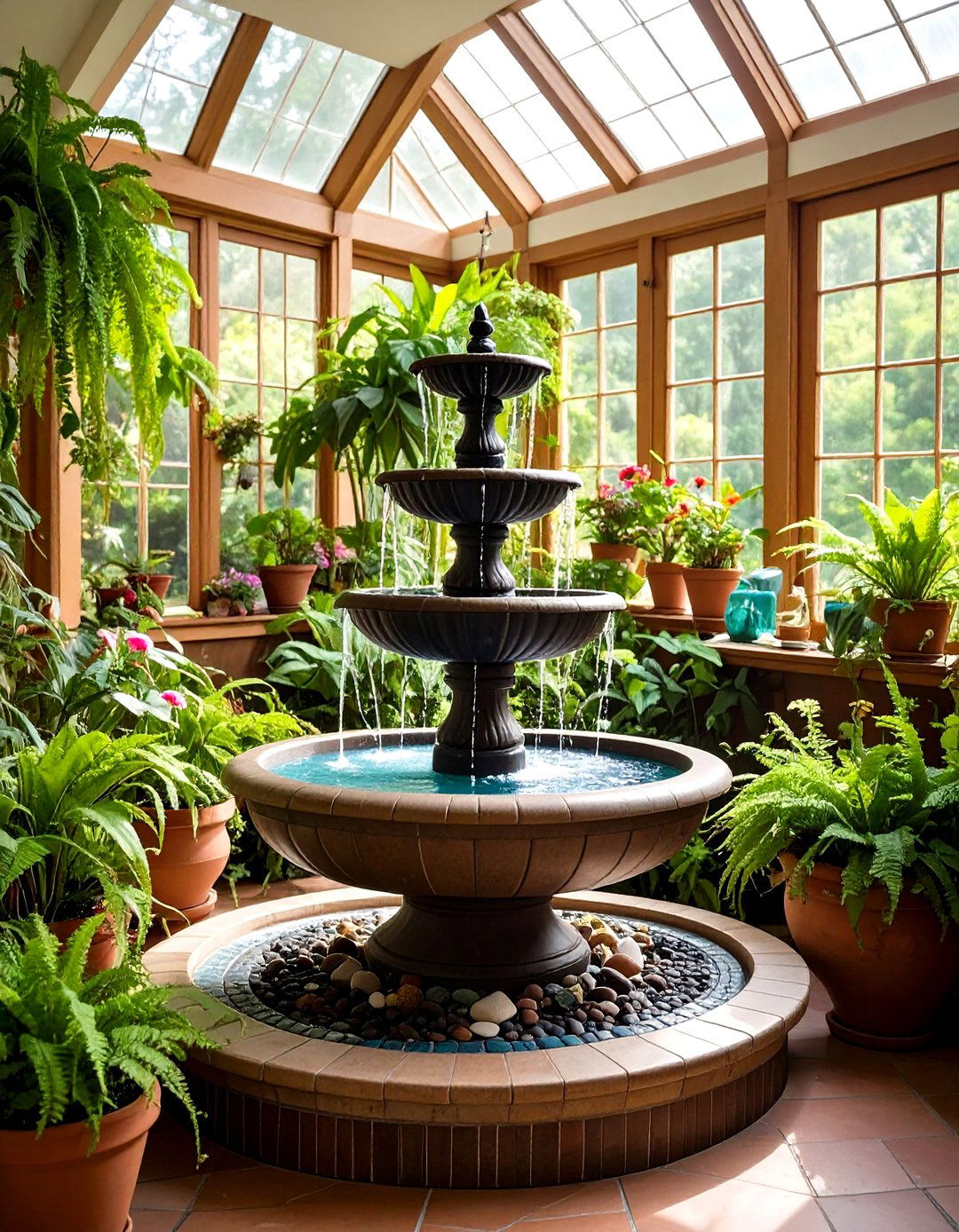
Install a freestanding cast-iron fountain with layered bowls and scrolled legs at the room’s center to channel Victorian conservatory water features. Line the basin with mosaic tile accents that coordinate with flooring patterns for seamless integration. Surround with low-growing ferns and moisture-loving plants to hide plumbing and enhance the microclimate. Use a quiet, submersible pump to maintain gentle water flow without overpowering the space. Accent the fountain base with pebbles or glass gems for texture and visual interest.
9. Patterned Ceiling Medallion
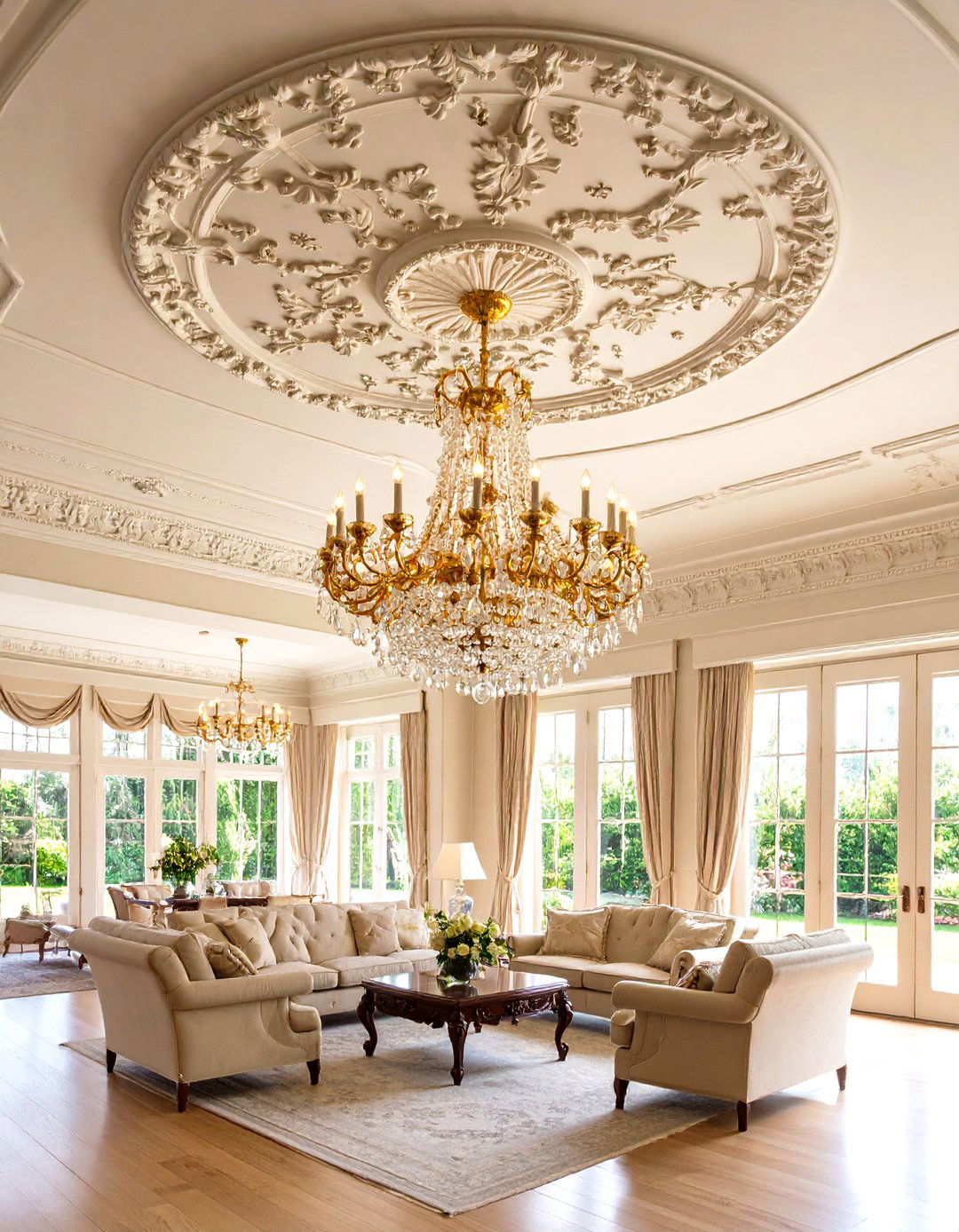
Highlight a central ceiling fixture by installing a cast-plaster medallion with foliate or ribbon motifs typical of Victorian interiors. Paint the medallion in a subtle tone—off-white or pale gold—to contrast with a deeper ceiling color, such as sage or dusty rose. Center a multi-arm chandelier within the medallion, its crystals or glass droplets refracting light throughout the room. Continue ceiling embellishment with narrow crown molding encircling the perimeter for added depth. Protect paint and plaster with a clear, moisture-resistant sealant in sun-exposed areas.
10. Painted Tin Ceiling Tiles
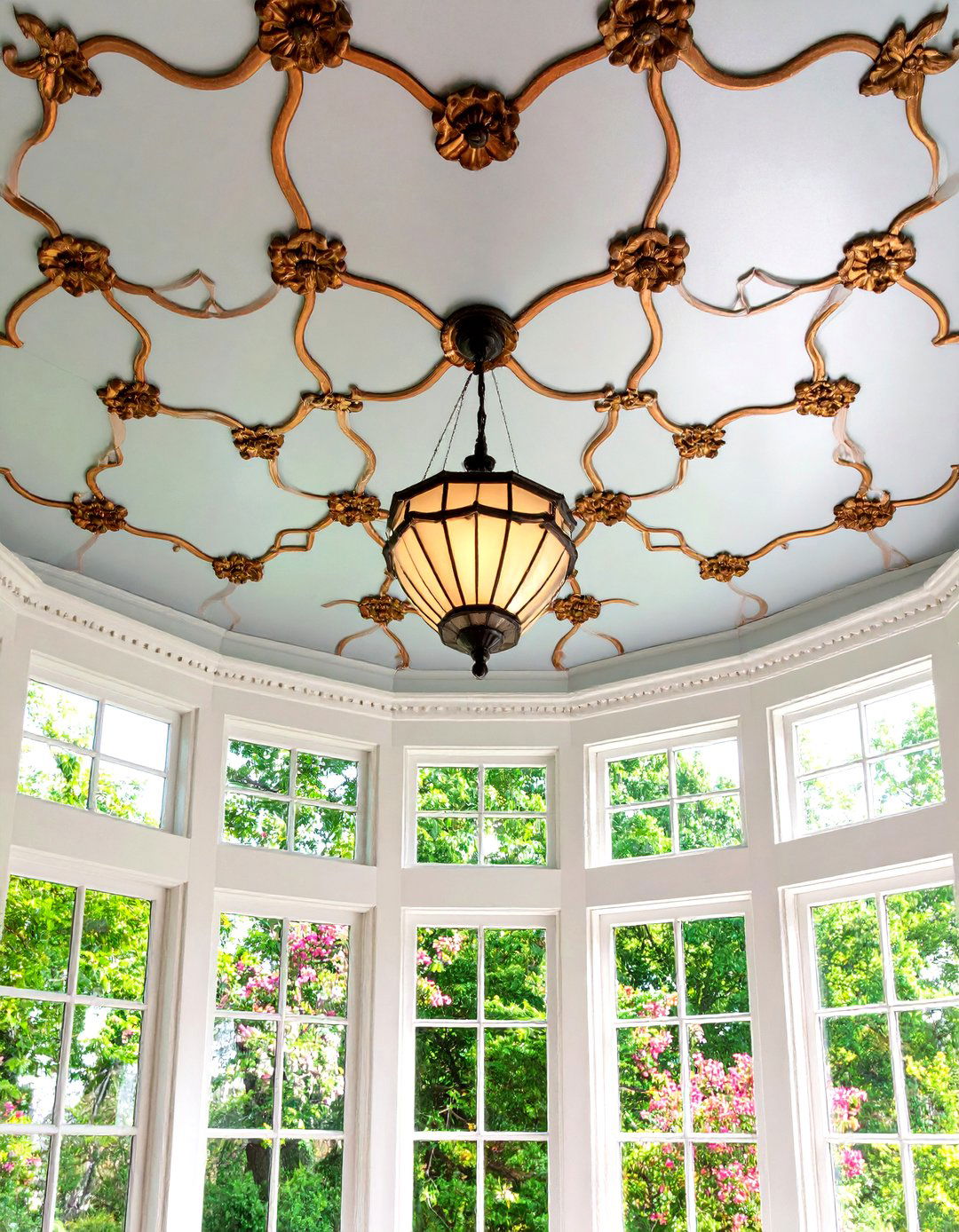
Cover the ceiling with pressed-tin tiles painted in metallic hues—silver, copper, or aged brass—to evoke vintage conservatory roofing interiors. Choose patterns featuring quatrefoils or floral scrolls that complement other carved details in the room. Install over a moisture-resistant underlayment to prevent rust and maintain structural integrity. Accentuate tile joints with thin, decorative beading painted to match to conceal seams. Pair with recessed uplighting along the perimeter for soft, even illumination.
11. Built-In Greenhouses Shelving
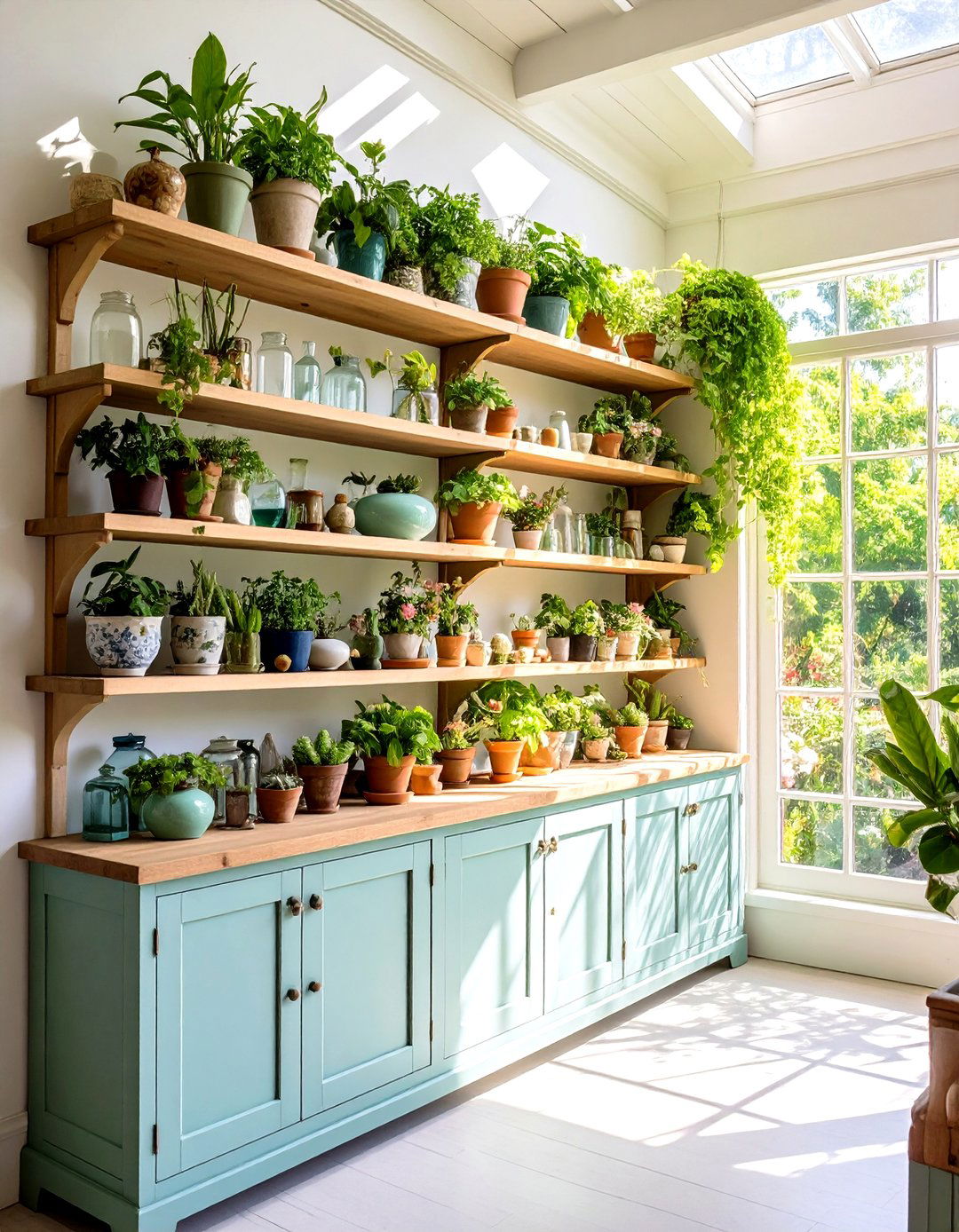
Construct built-in wooden shelving units along one wall with glazed doors and adjustable shelves for plant display, mimicking Victorian hothouse cabinetry. Paint shelving in muted cream or sage green to contrast with darker wall hues and highlight plant life. Integrate glass-fronted cabinets below for storage of pots and gardening tools, keeping the sunroom tidy. Line shelves with removable trays for easy watering and drainage management. Top cabinets with carved cornices to maintain decorative continuity.
12. Period-Appropriate Radiators
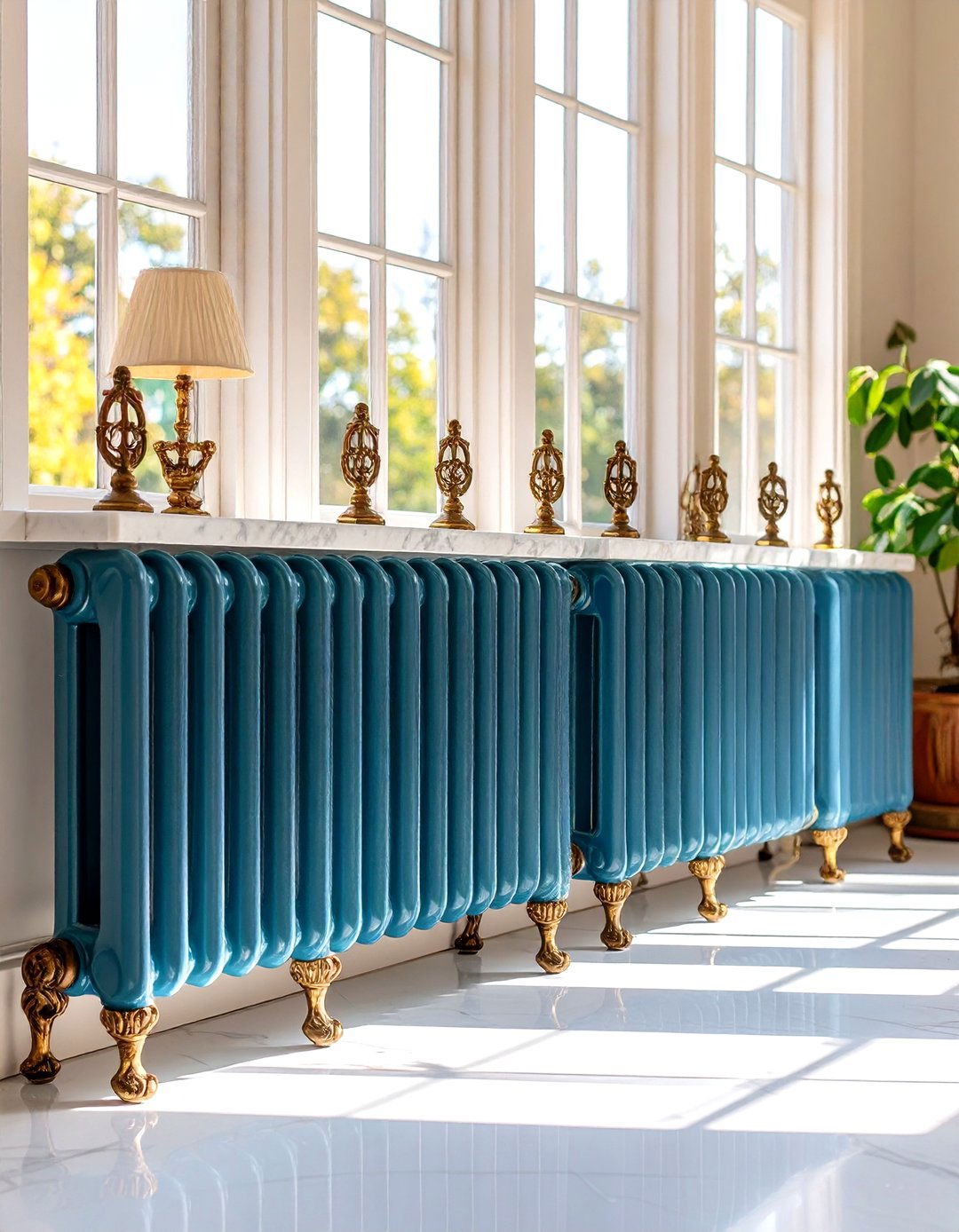
Replace modern HVAC vents with cast-iron radiators featuring scrollwork or column designs, painted to match woodwork for a seamless look. Position radiators beneath windows to optimize heat distribution and hide them with decorative wooden covers featuring fretwork. Incorporate a marble top on cover units to serve as additional display space for plants or books. Ensure proper airflow by selecting covers with removable panels for maintenance. Add thermostatic radiator valves with antique brass finishes for precise climate control and style cohesion.
13. Decorative Frieze Band

Paint or apply a stenciled frieze band just below the ceiling around the perimeter, featuring acanthus leaves or damask scrolls in contrasting hues. Use custom stencils and high-quality, fade-resistant paints to withstand sunlight without yellowing. Mirror the frieze pattern on window valances or chair upholstery for visual harmony. Highlight the stencil with metallic accents—gold or silver—to catch light and emphasize detail. Finish edges with thin gold-leaf lines for crisp definition.
14. Victorian Color Palette
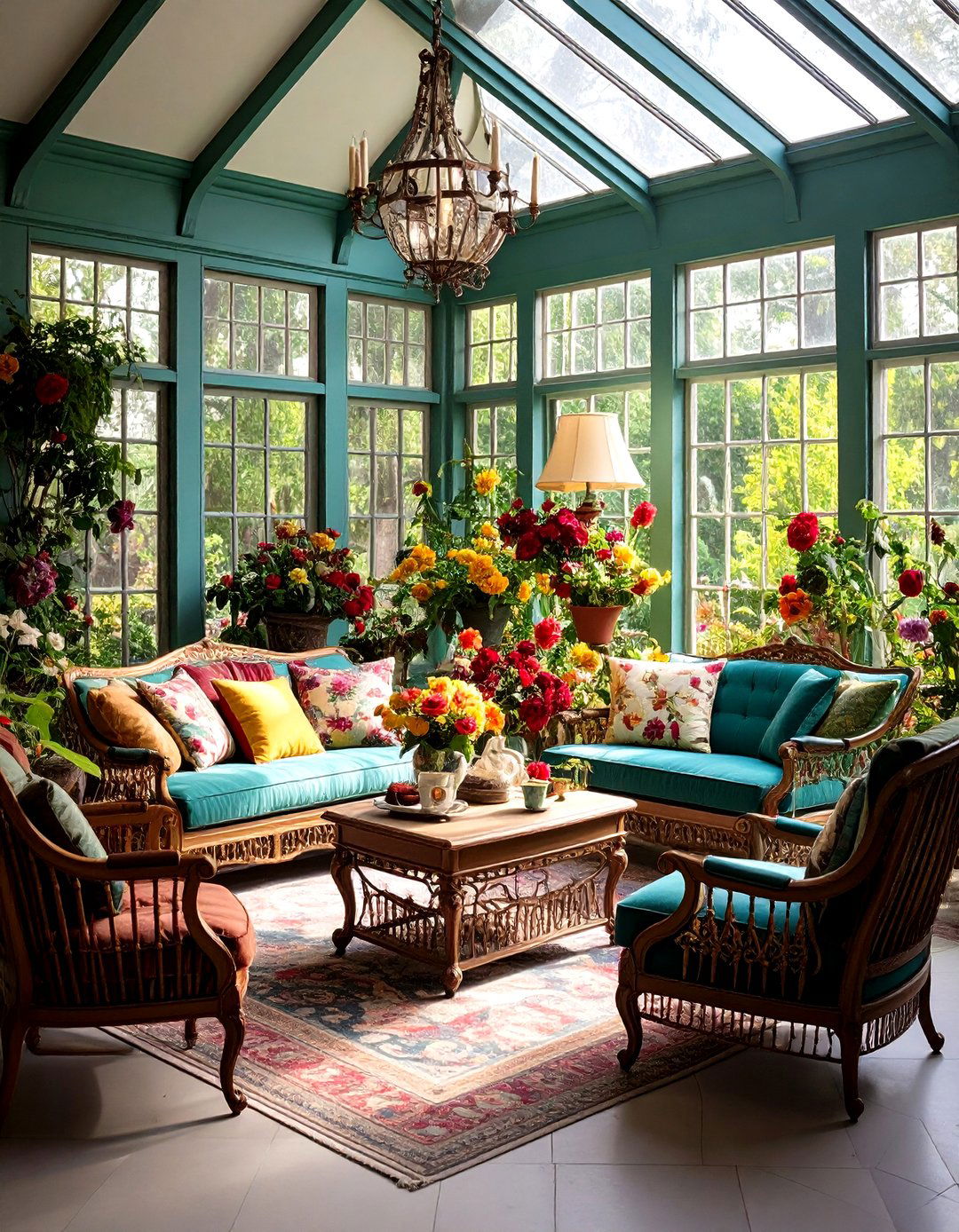
Select a palette of muted jewel tones—olive green, burgundy, mustard yellow, and dusty rose—balanced with neutrals like cream and charcoal. Apply darker shades to lower walls or panels, with lighter hues above to keep the room feeling airy. Introduce accent colors through textiles—throw pillows, curtains, and rugs—that echo main paint choices. Use metallic finishes sparingly on fixtures and hardware to add warmth without overpowering the scheme. Test samples in different light conditions at various times of day to ensure color integrity under sunroom illumination.
15. Upholstered Chaise Lounge
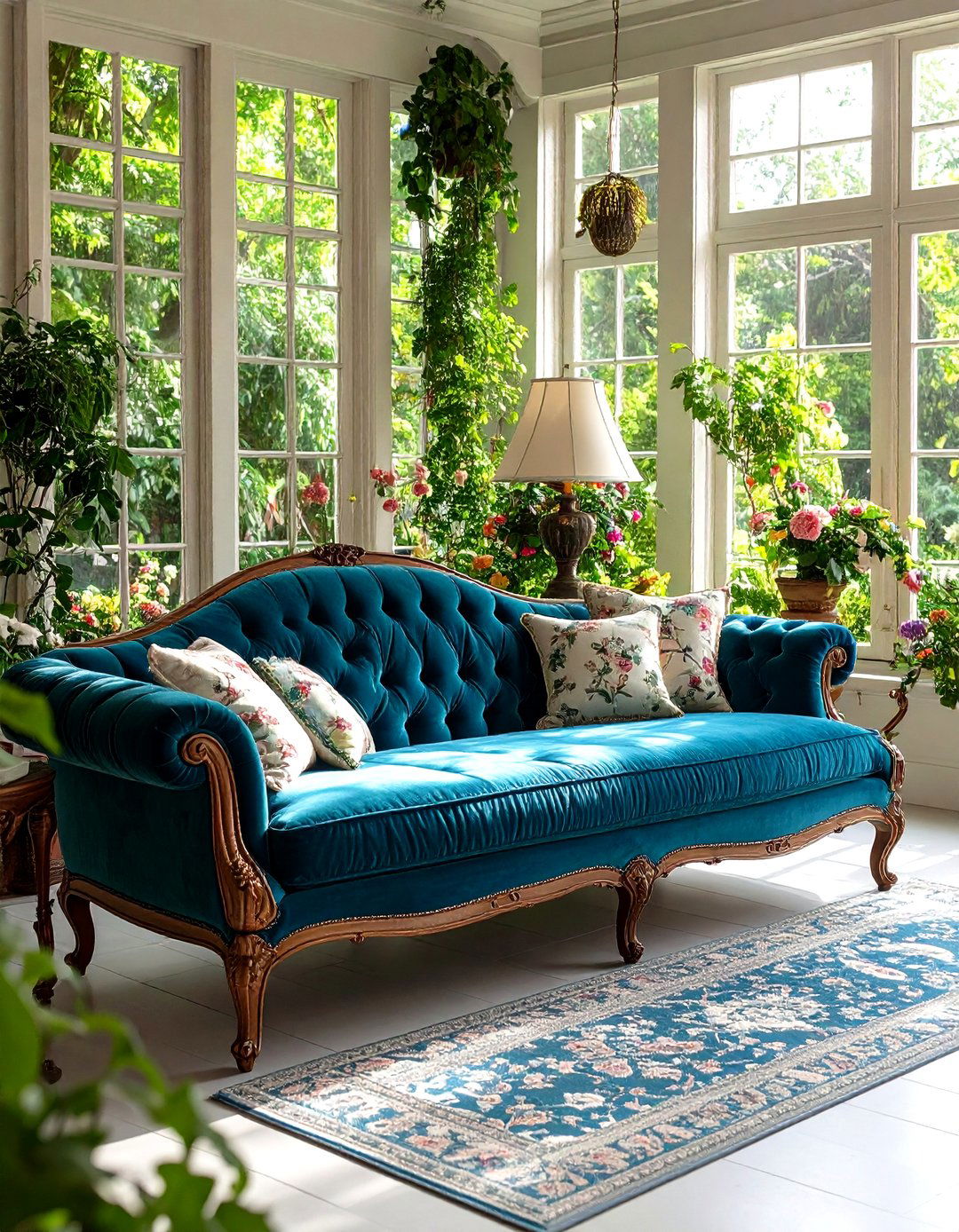
Place an elegant chaise longue with scrolled arms and tufted velvet upholstery in a rich jewel tone as a focal seating element. Select cabriole legs in stained wood or painted finish to match other trim. Position near a bay window or under the skylight for optimal reading or napping light. Accent with bolster pillows in complementary patterns—stripes or florals—for layered visual interest. Place a small side table beside it, topped with a decorative porcelain vase or antique tray.
16. Lace-Trimmed Sheer Curtains
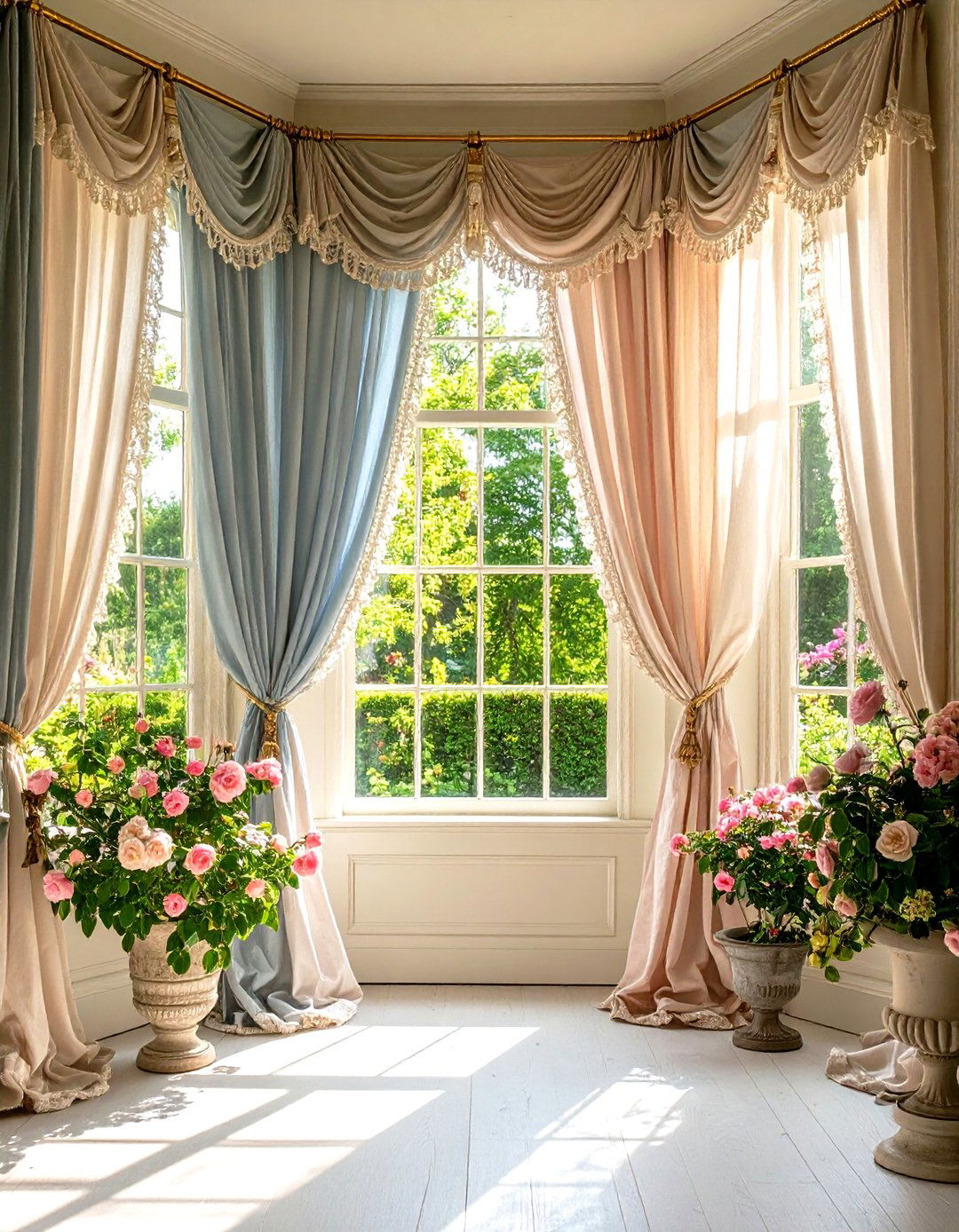
Hang floor-to-ceiling sheer curtains edged with lace to filter harsh sunlight and reinforce Victorian textile traditions. Choose lightweight linens or cotton blends that billow with airflow, enhancing the sunroom’s breezy feel. Layer behind heavier draperies for privacy during evenings without obstructing daylight. Attach to brass curtain rods with decorative finials—acorn or fleur-de-lis motifs—for period accuracy. Maintain curtain length just grazing the floor to prevent dirt accumulation while allowing gentle movement.
17. Mosaic Accent Wall

Create a feature wall clad in small mosaic tiles—glass or ceramic—arranged in geometric or floral patterns echoing floor motifs. Limit the accent to one wall to avoid overwhelming the space, ideally the one facing the main seating area. Use a grout color that contrasts slightly to emphasize individual tiles without disrupting the overall palette. Seal with a clear, UV-resistant finish to protect from sun exposure and moisture. Frame the mosaic with narrow wood trim painted to match surrounding moldings for coherence.
18. Hanging Victorian Lanterns
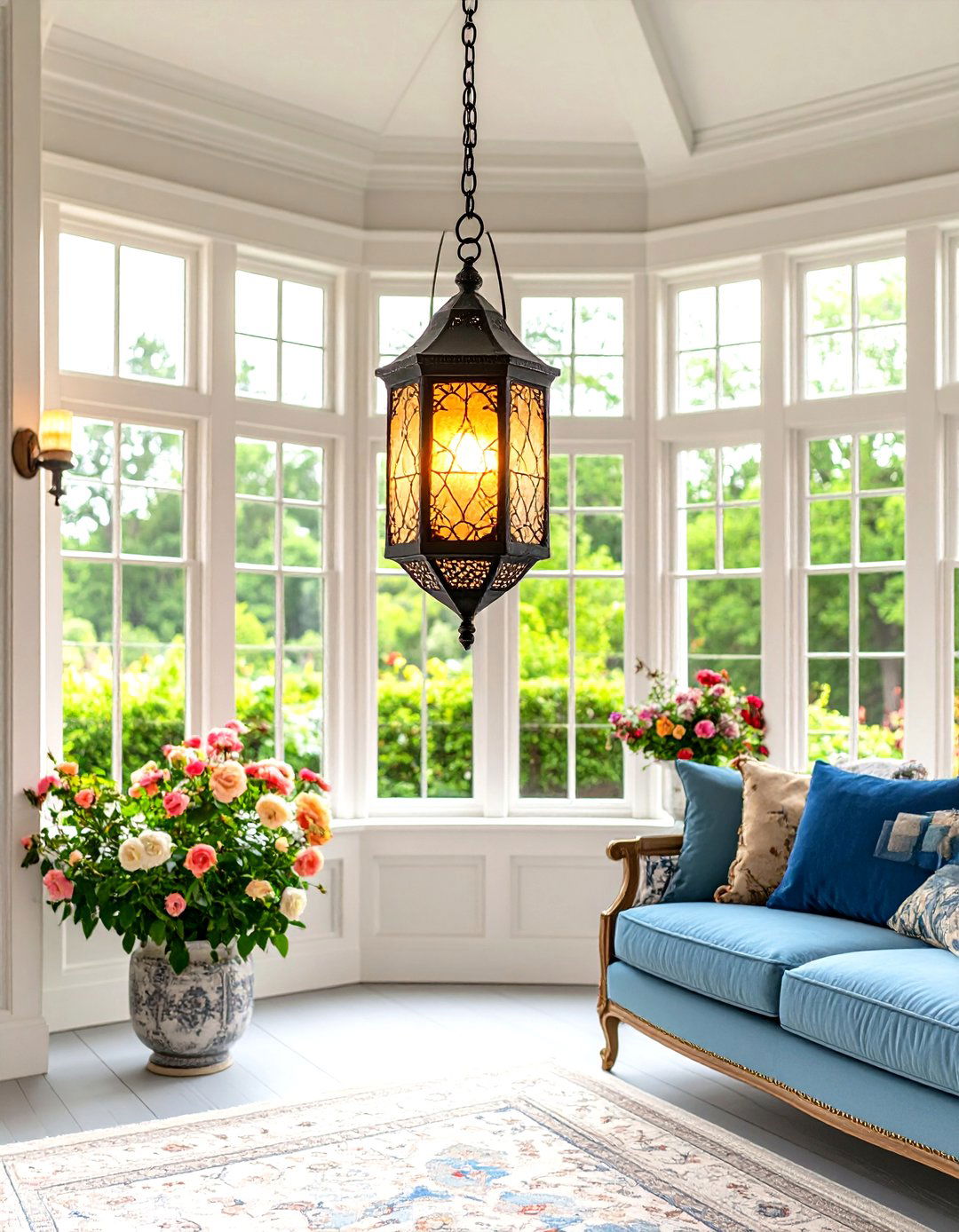
Suspend one or more lanterns with etched glass panels and wrought-iron frames from the ceiling beams to provide ambient evening lighting. Chain lengths should be adjustable to accommodate ceiling height and ensure lanterns hang at eye level. Choose LED-filament bulbs for a warm, flicker-free glow that mimics candlelight. Position lanterns evenly or staggered for balanced illumination without dark corners. Pair with wall-mounted sconces of similar style for layered lighting.
19. Custom Leaded-Glass Sidelights
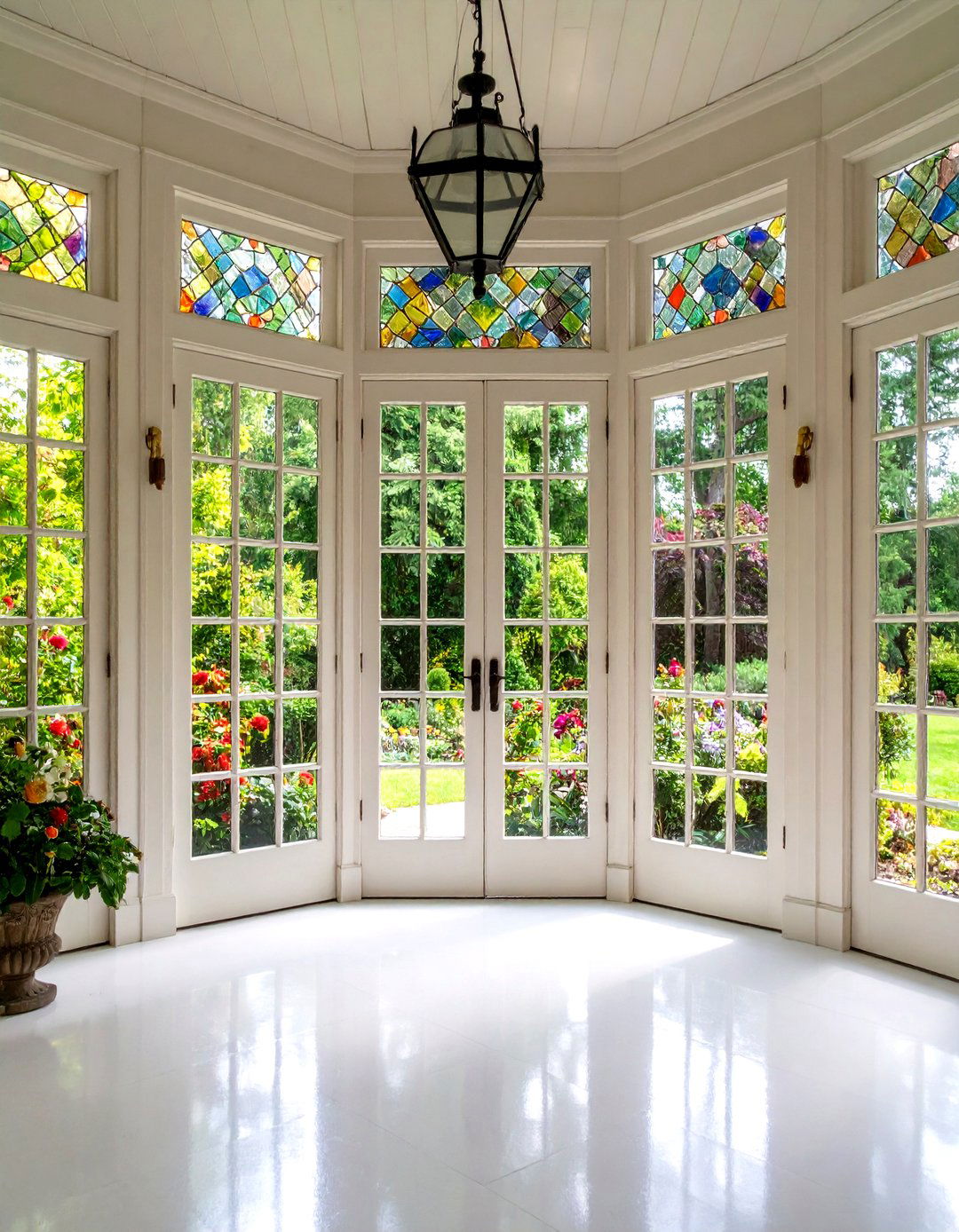
Flank French doors or large windows with narrow sidelights featuring leaded-glass panels in complementary patterns—trellis, florals, or geometric. Use translucent clear glass accented with colored jewels for privacy without sacrificing light. Frame sidelights in matching wood trim, stained or painted to coordinate with window frames. Incorporate small vents at the bottom of sidelights concealed by brass grilles for discreet airflow. Include matching transom panels above doors for a cohesive elevation.
20. Indoor-Outdoor Transition Doors

Install French or sliding patio doors with multi-paned glass that echo sunroom windows, creating seamless flow between garden and interior. Choose doors with operable transoms or side vents to allow fresh air without full exposure. Frame with carved pilasters and an entablature featuring dentil molding for formal grandeur. Stain or paint doors to match interior moldings, ensuring cohesion across the threshold. Dress with wrought-iron hardware—handle sets and hinges—to reinforce Victorian character.
Conclusion:
By weaving together bay windows, stained-glass details, carved woodwork, and period textiles, these twenty ideas honor Victorian heritage while delivering modern comfort. From patterned floors to ornate ceilings and botanical accents, each element enriches the sunroom’s character, transforming it into a luminous retreat that feels both timeless and inviting. Whether you cultivate an indoor garden, lounge in a velvet chaise, or entertain beneath Tiffany lamps, these design strategies ensure your Victorian sunroom remains a cherished sanctuary year-round.


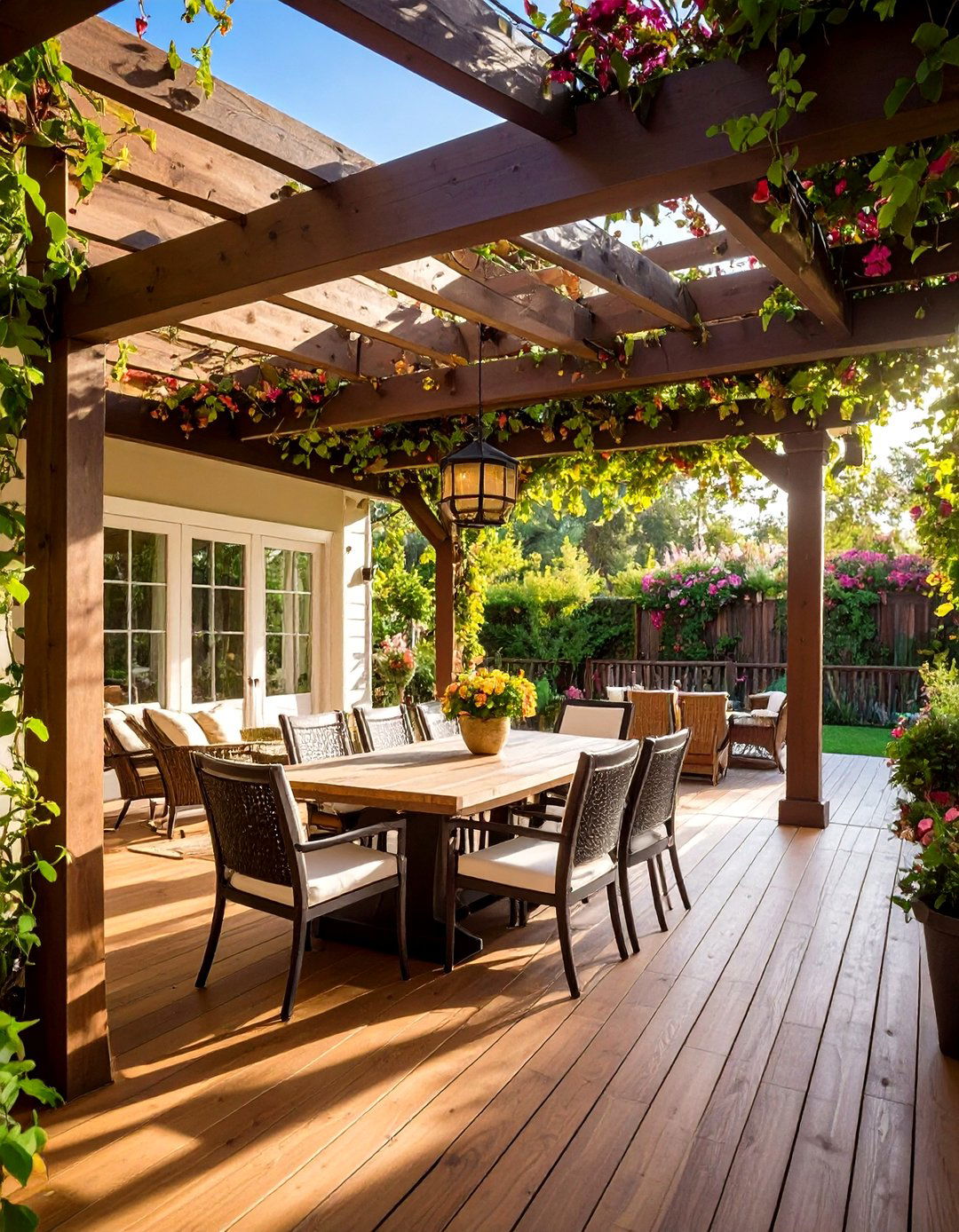
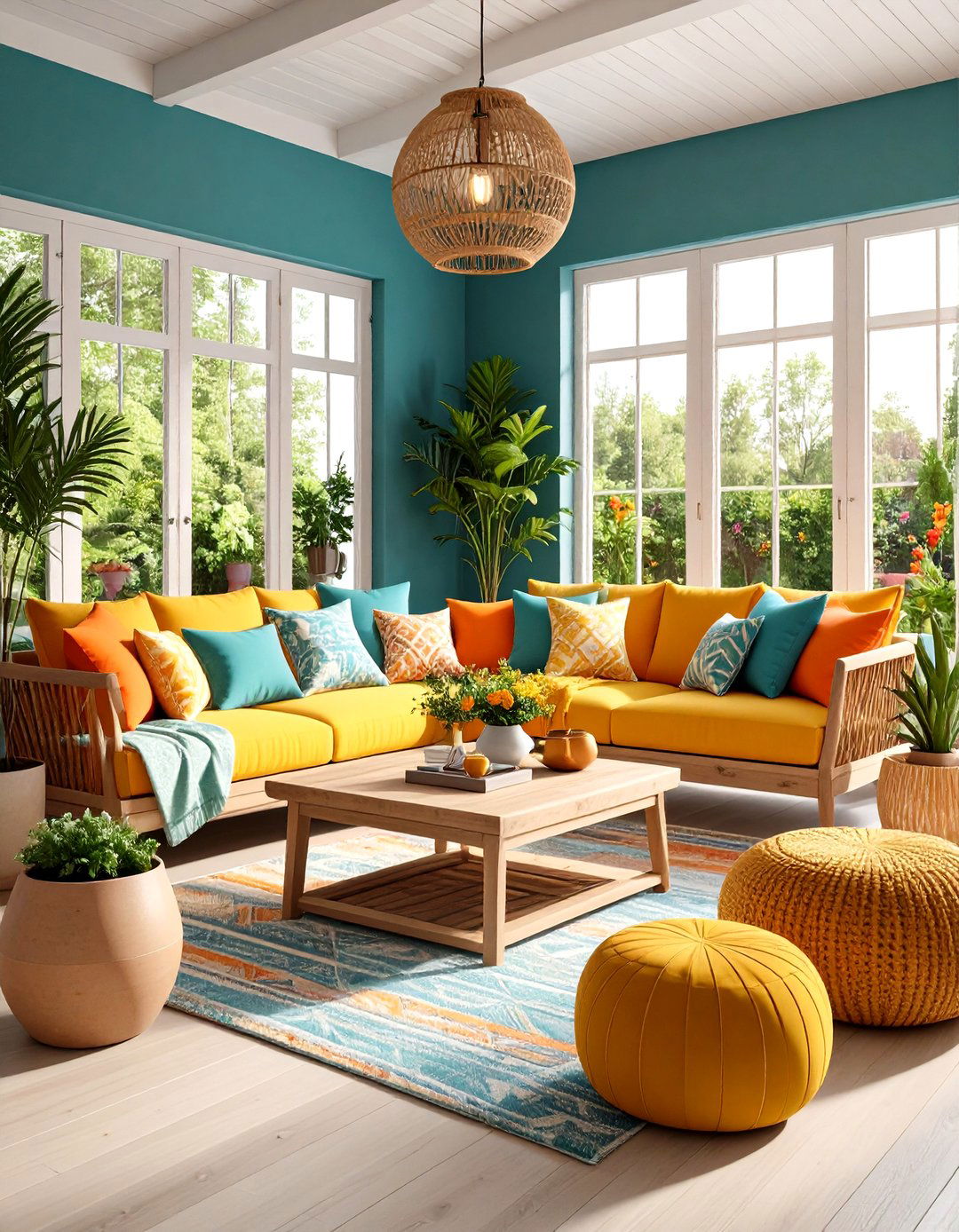
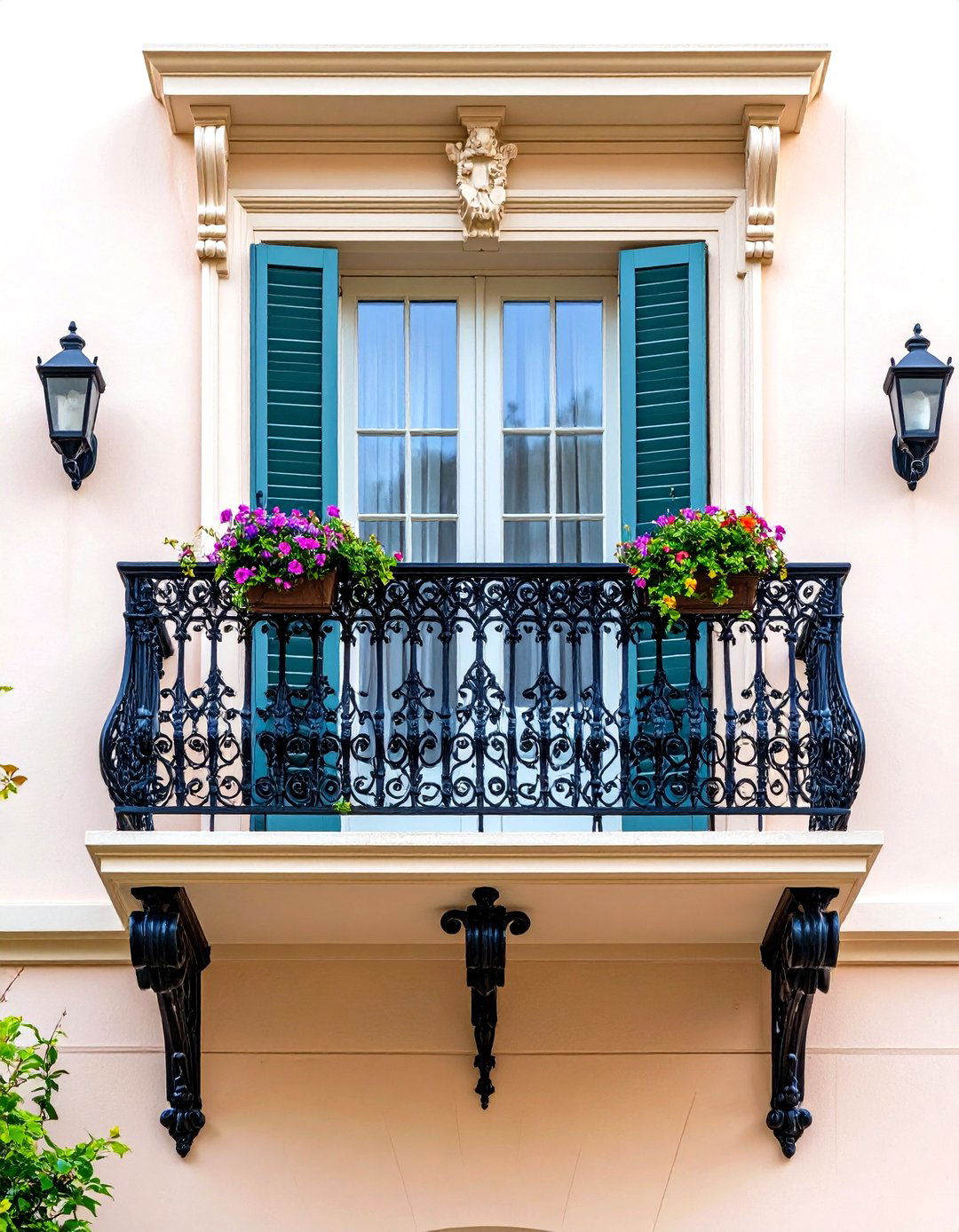
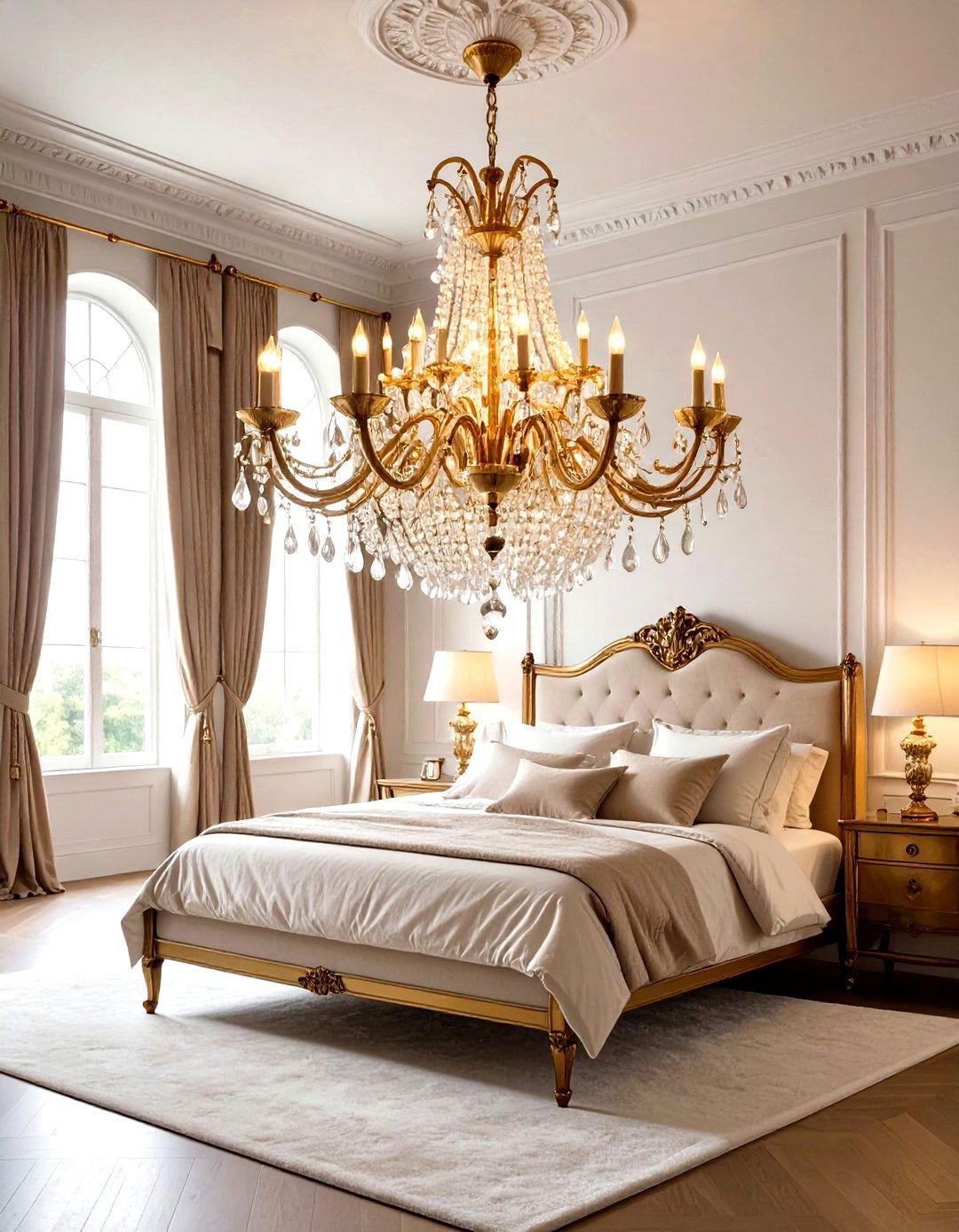

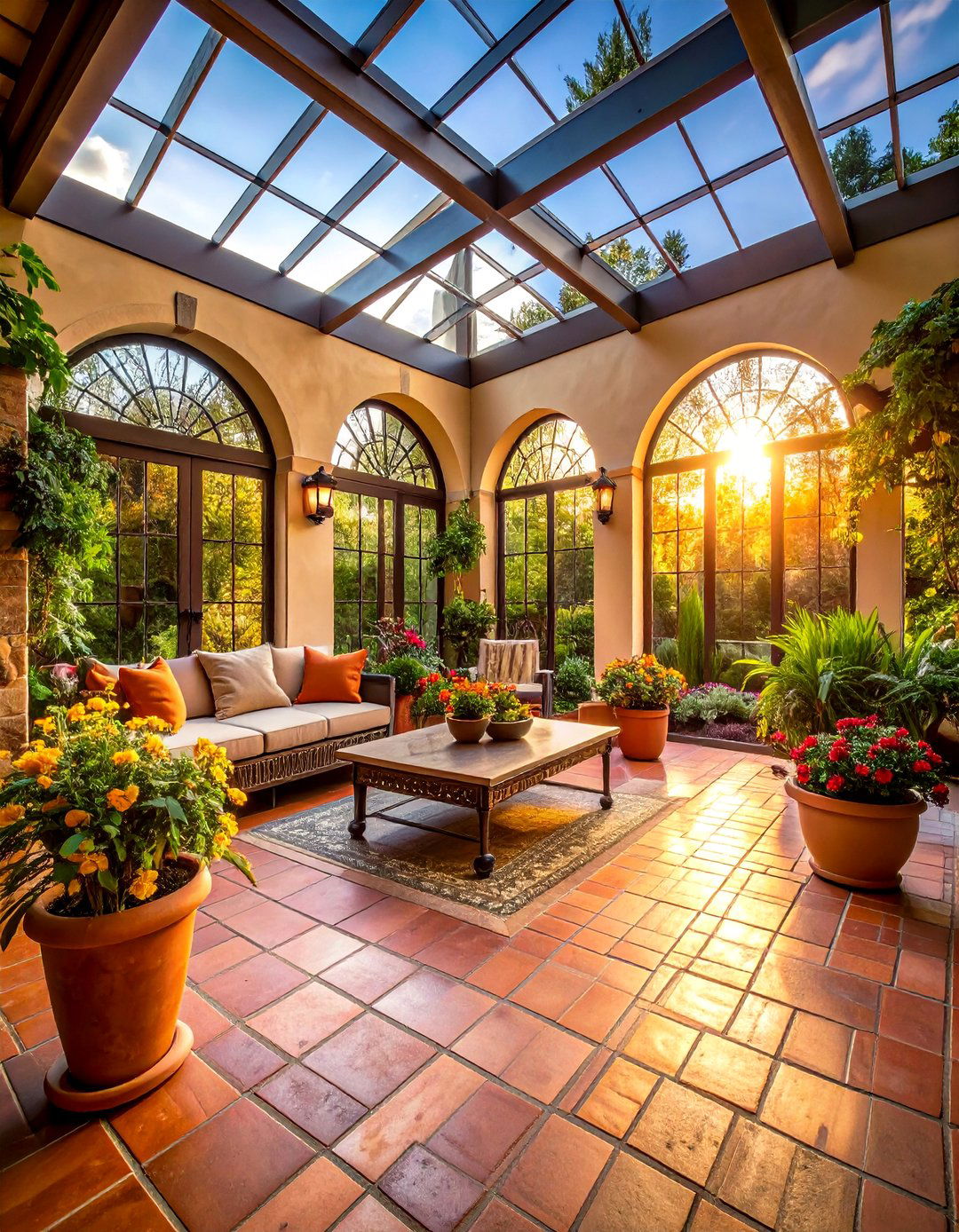
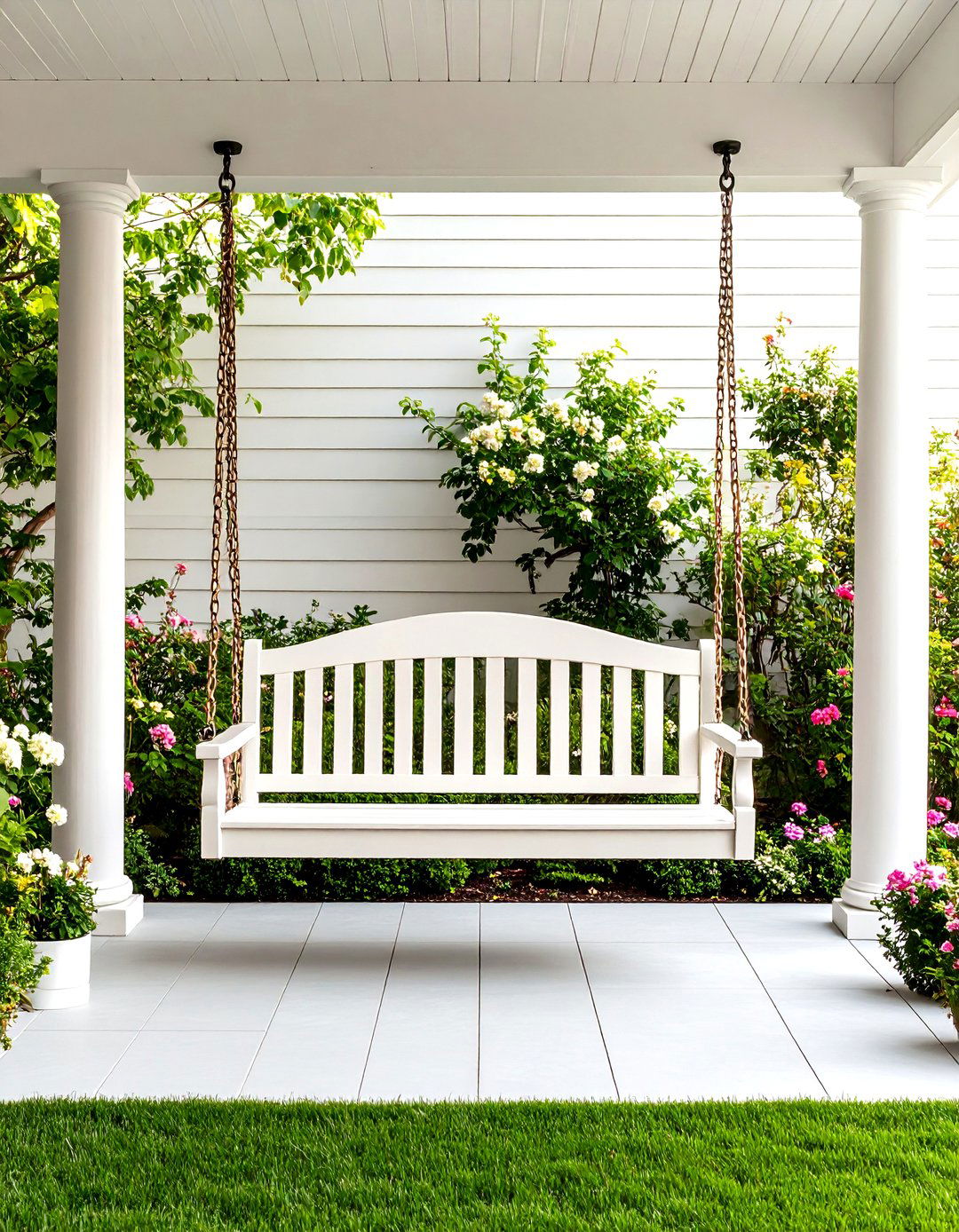
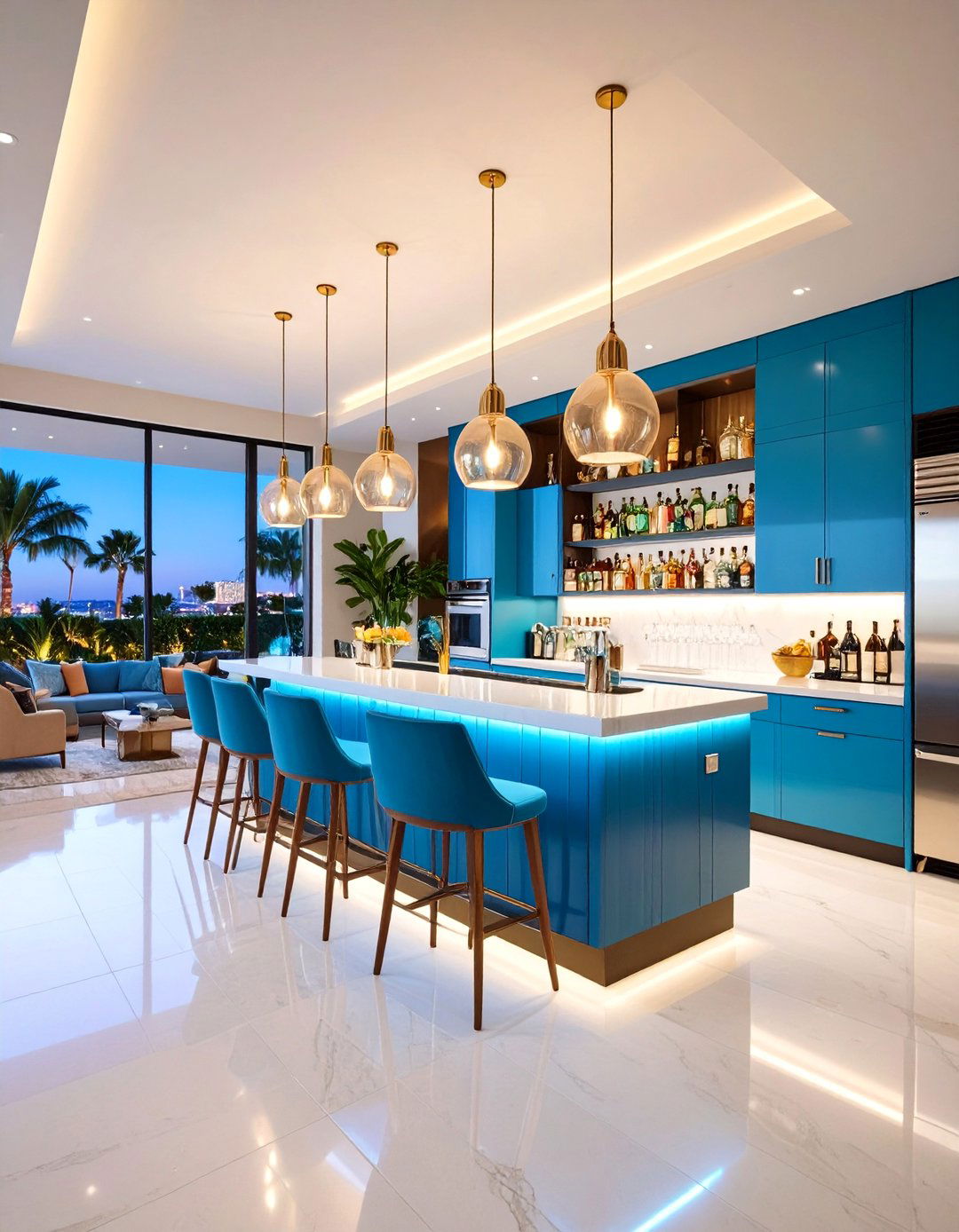

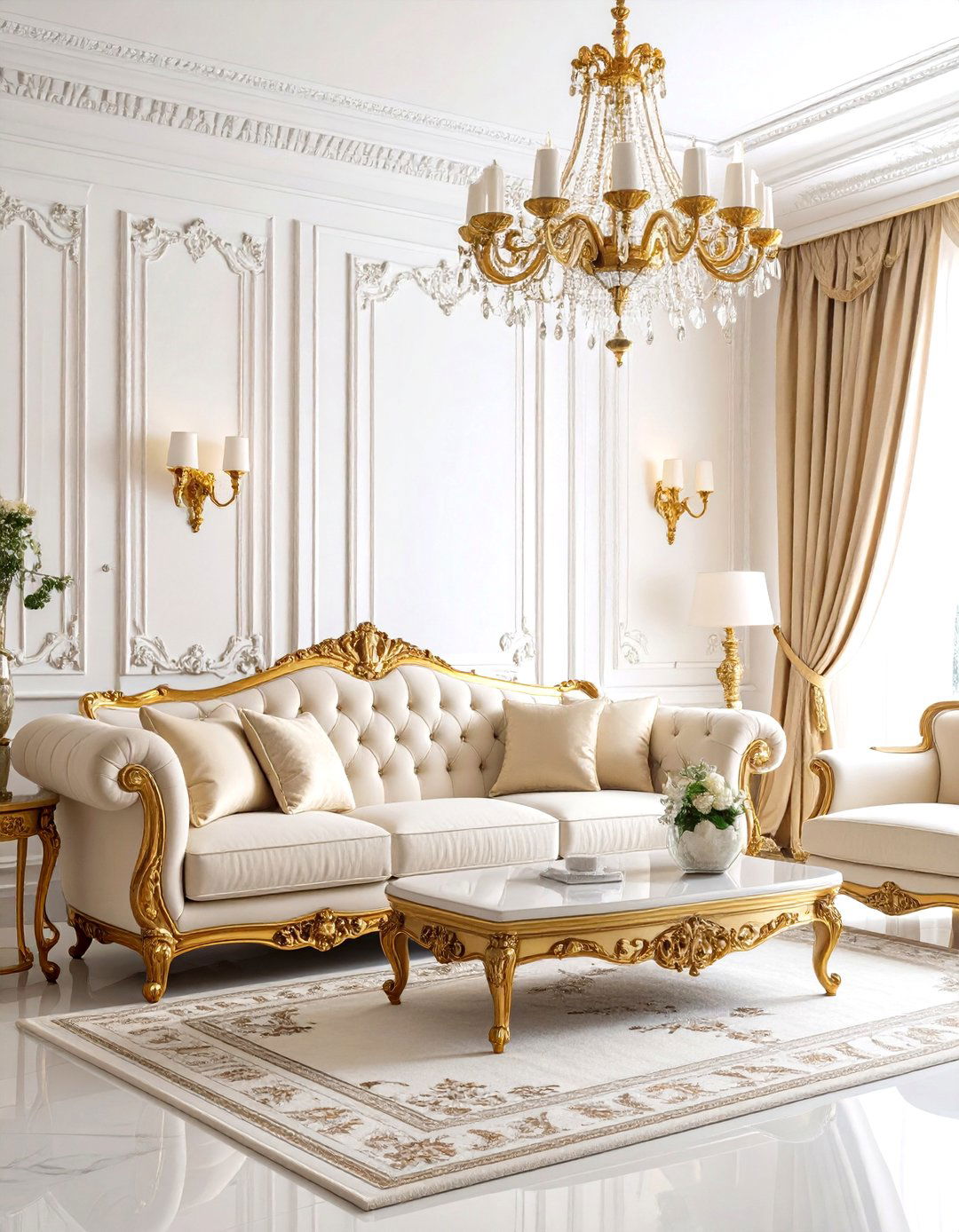
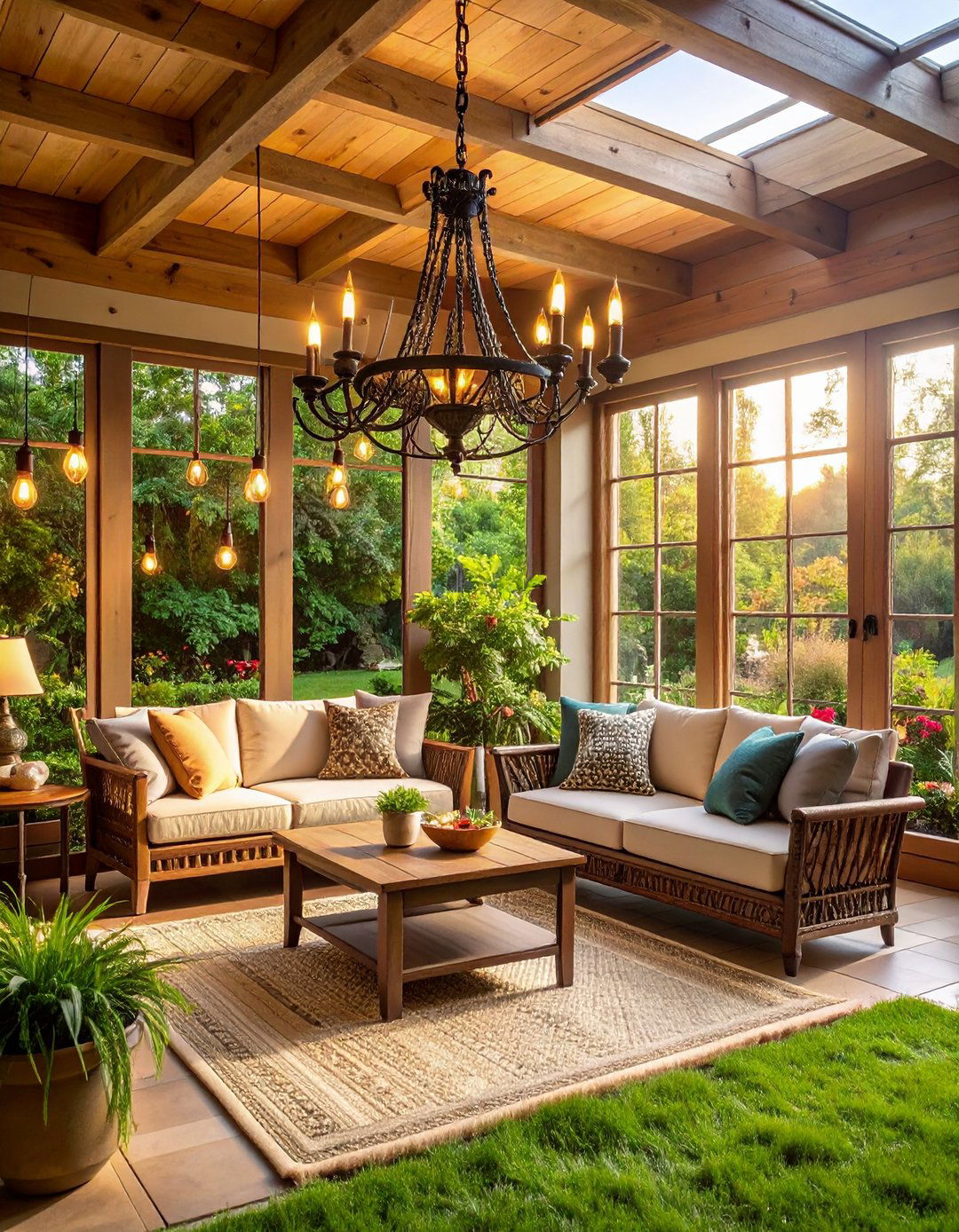

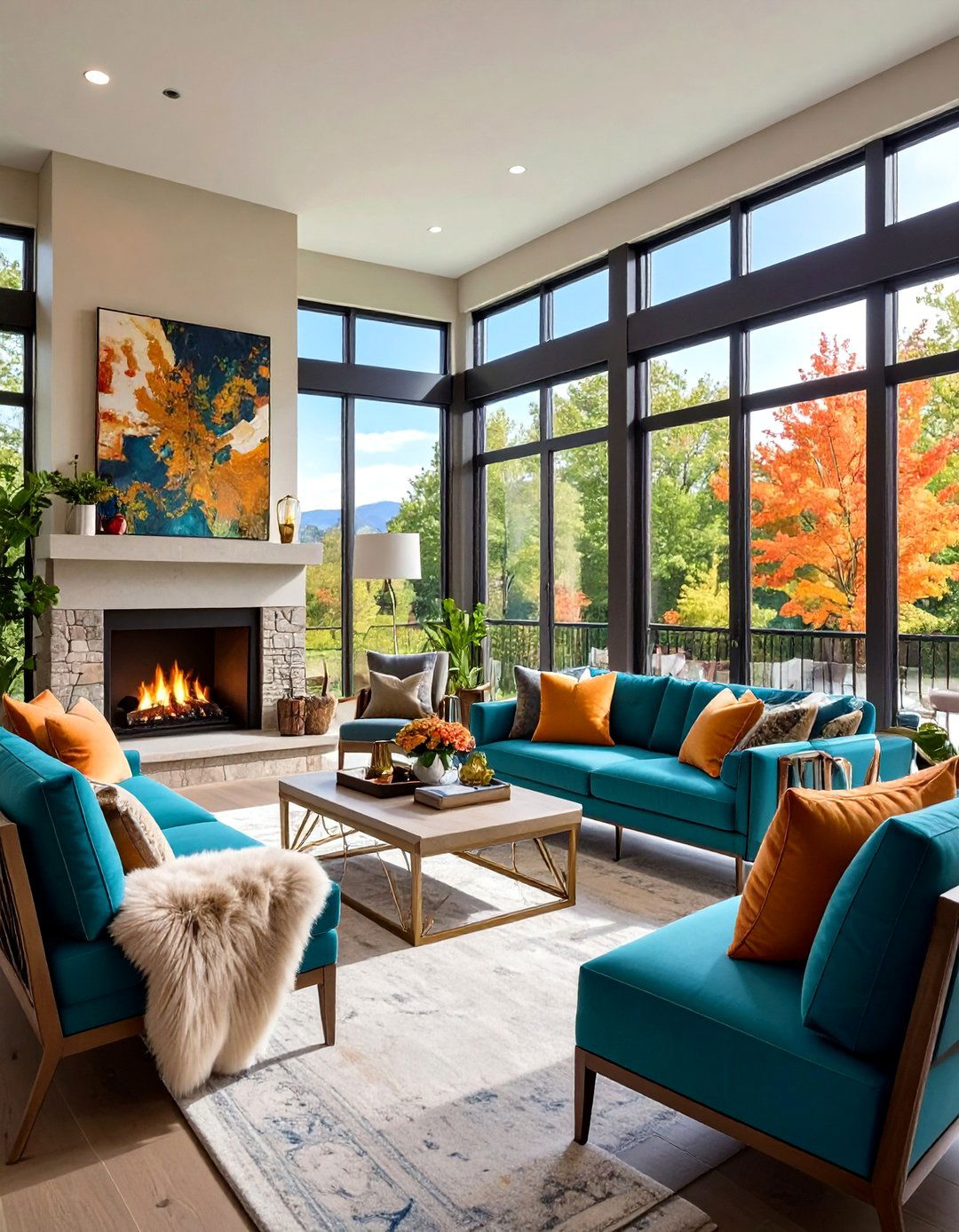
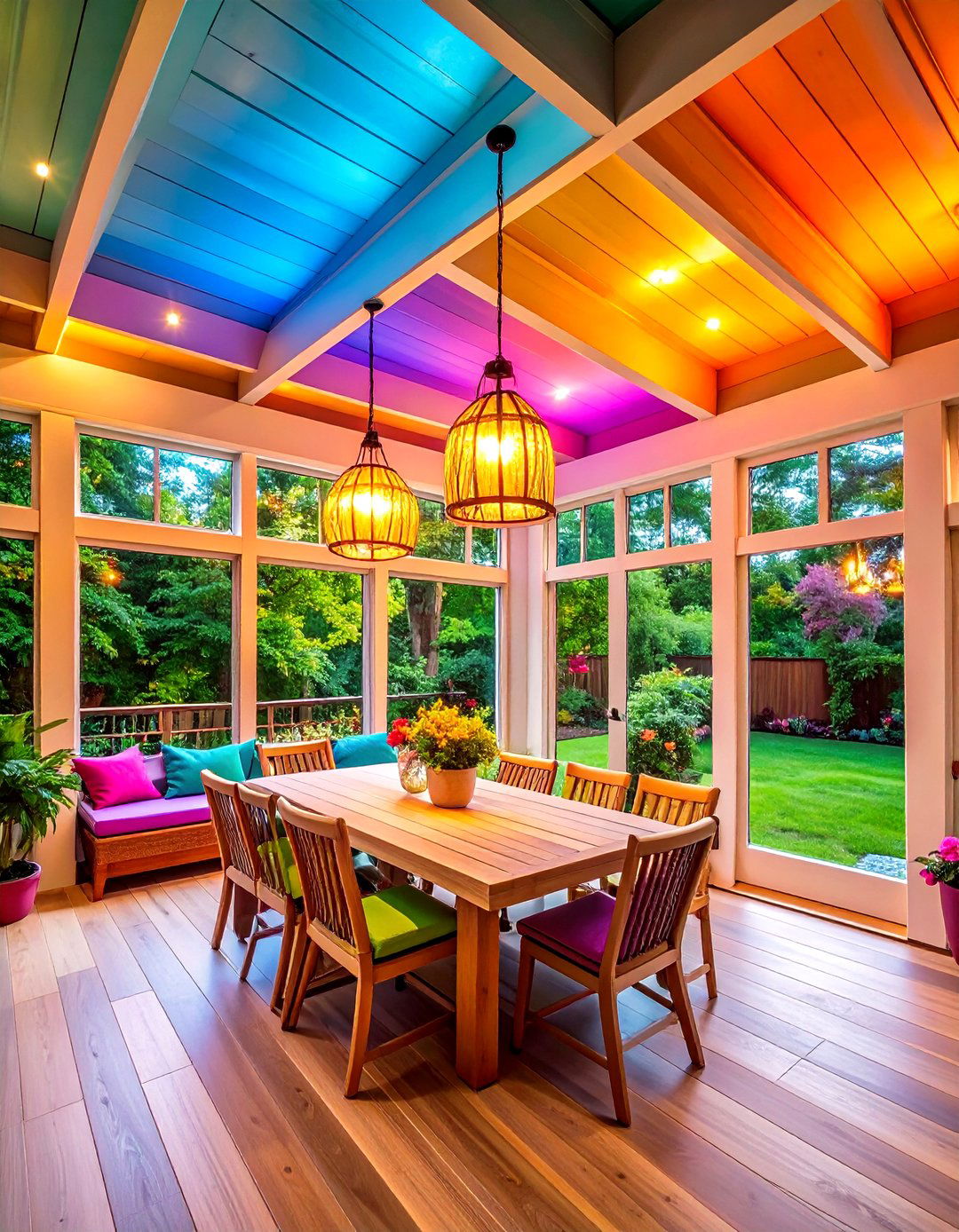

Leave a Reply